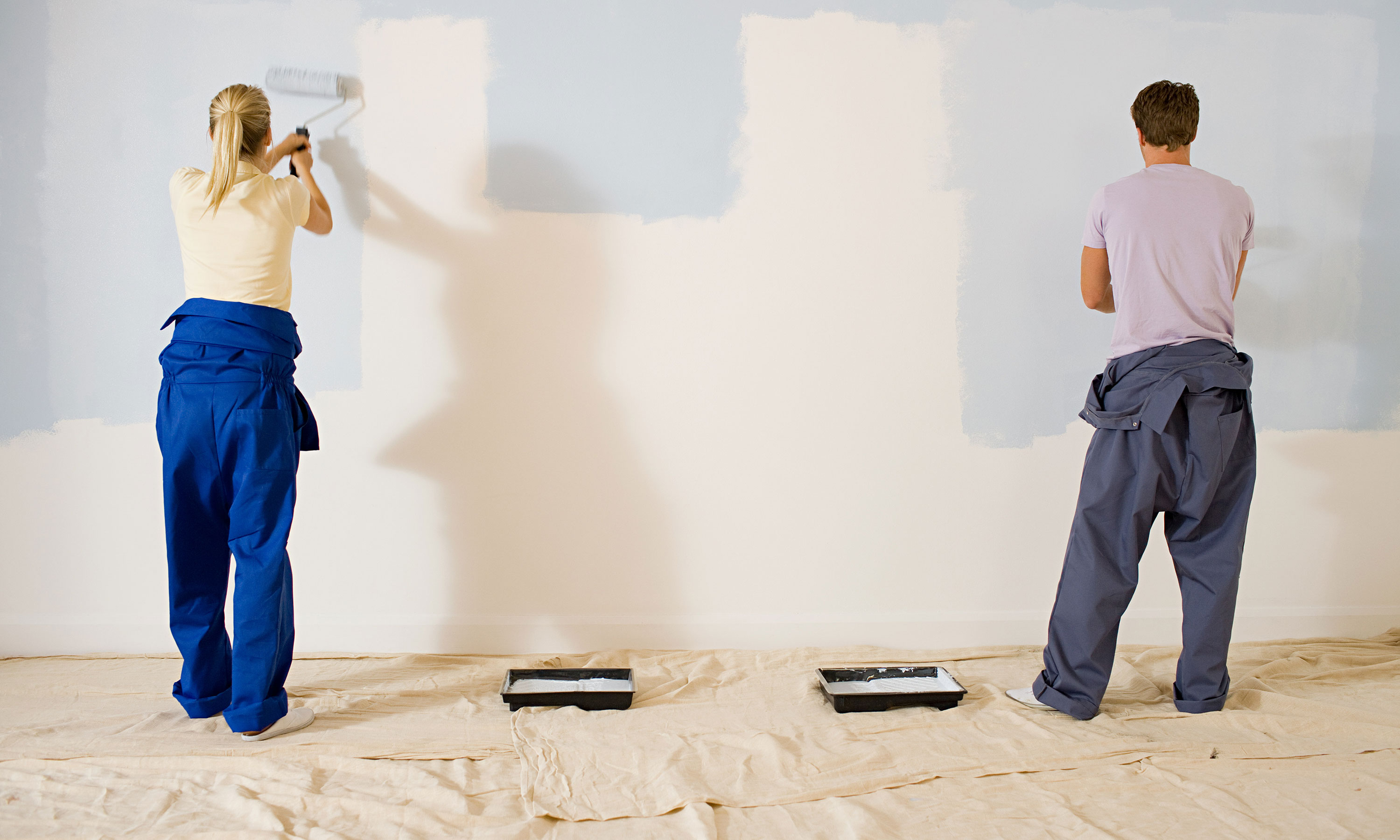

There are many occasions where you might need to know how to paint on new plaster. Perhaps you have had a room re-plastered, or built a new space with completely fresh walls.
Painting a room is one of the easiest, cheapest – and not to mention most effective –DIYs out there. You just need to choose one of the best kitchen paints, one of the best washable paints, or one of the best bathroom paints, depending on the room you're doing. But, if you're painting new plaster, it's a whole different ball game. You need to understand the unusual properties of fresh plaster, any priming involved and more for a professional finish. You'll need to factor in just a little patience also...
How to paint on new plaster
The experts at Farrow & Ball say 'It’s really important that new plaster and plasterboard is fully dry before you paint over it. For new work, like new plaster, dilution of the first coat known as the mist coat is essential, as this allows the paint to sink into the surface and bind to it. Follow with two full, undiluted coats to finish.'
What will you need to paint on new plaster?
- The best paint rollers and a paint tray
- A small paint brush
- Protective sheets
- Stepladder
- Emulsion paint
- Water
- Gloves
- Masking tape
1. Make sure the plaster is dry
Plaster will suck up any moisture like a sponge, so the longer you leave it to dry, the easier it will be to achieve an even result. The time it takes for plaster to dry out will depend on the room's temperature, ventilation and the plaster's thickness.
As a general rule, wait four weeks per 5mm of plaster depth. Ensure that there are no dark patches on the freshly-plastered surface before you being to paint – a uniform, light, color is a good indicator as to whether your plaster has dried thoroughly.
Newly built or altered rooms also take a while to settle, so waiting will mean you can fill any cracks that form as a result, before you paint.
2. Make a mist coat
Fresh plaster is extremely porous, and any moisture will be quickly absorbed into the wall. This is why you need to water down your first paint layer (known as a mist coat).
To make a mist coat, combine a cheaper emulsion paint in a similar color to your top coat with water. The ratios for this will vary according to the paint you are using, so check what it says on your paint tin – but around three parts paint to one part water should suffice.
Stir the solution until you have an even consistency with no water sitting on top of the paint. Fresh plaster needs to be able to breath underneath the paint to allow any moisture to escape, so make sure to use a non-vinyl water-based paint.
Top tip: If you have lots of rooms to paint, a big batch of white trade emulsion will see you through several rooms worth of mist coat.
3. Prime with a mist coat
Applying the first coat of mist paint can be a messy job as the paint will be thin and runny, so make sure you have put down dust sheets and covered any furniture. Fix masking tape along the skirting/baseboards and any trim to protect them, and cover light switches or sockets and windows.
Pour the mist coat into a paint tray then roll an even amount on to a foam roller. Roll it over the plaster in smooth, upward motions until you have covered the whole surface. Use a smaller paint brush to get into any corners or areas that cannot be reached with the roller.
Top tip: When applying your mist layer to fresh plaster, keep an eye out for any drips, rolling over them before they dry.
4. Allow the mist coat to dry
A mist coat will take around 24 hours to dry, but this will depend on the conditions in the room. Once dry, you can start applying top coats.
5. Apply the top coats
If you are right handed, start in the top left hand corner of a wall and work to the right. If you are left handed, work in the opposite direction. This will stop you getting any paint on your beloved decorating dungarees.
Cut in paint around the corners of the wall using a brush and fill the rest of the wall using a roller. And allow the first coat to dry thoroughly (overnight if you are unsure) before adding a second coat.
Can I paint straight onto new plaster?
The mist coat paint step once the freshly plastered wall is completely dry, is essential, as this acts as a primer. The correct ratio according to Dulux is 'Three parts paint to one part water should work' and if you want a (slightly) less messy job, you can cheat with Dulux Sealer for Plaster. Remember also to fill any holes in plaster ahead of starting this project for an even smoother finish.
What happens if the mist coat is too thick?
You'll be able to tell if your mist coat is mixed too thickly as it won't absorb very well onto the new plaster. This can be the case with some shop bought plaster sealers, so if you are buying one rather than mixing emulsion paint and water yourself, first try what you've bought on a small patch. If it comes out a little thinner than single cream consistency and doesn't sit on the surface it should be fine to go ahead. If it does sit on the surface and seems a little too thick, it's likely you'll have to water it down a further 50/50.
Join our newsletter
Get small space home decor ideas, celeb inspiration, DIY tips and more, straight to your inbox!
Hebe joined the Real Homes team in early 2018 as Staff Writer before moving to the Livingetc team in 2021 where she took on a role as Digital Editor. She loves boho and 70's style and is a big fan of Instagram as a source of interiors inspiration. When she isn't writing about interiors, she is renovating her own spaces – be it wallpapering a hallway, painting kitchen cupboards or converting a van.
-
 A $200 fluted panel transformed my drab kitchen in just one weekend
A $200 fluted panel transformed my drab kitchen in just one weekendHow to install a fluted kitchen panel: A speedy and achievable DIY tutorial even for DIY novices
By Claire Douglas Published
-
 How to replace a broken staircase spindle in 30 minutes flat
How to replace a broken staircase spindle in 30 minutes flatA missing or broken spindle on a staircase is not only unsightly, but it can be a real hazard. This is how to fix it in a few quick steps.
By Kate Sandhu Published
-
 An IKEA Billy bookcase hack inspired this cute media wall DIY
An IKEA Billy bookcase hack inspired this cute media wall DIYThis cute DIY was inspired by an IKEA Billy bookcase hack and brought a ton of symmetry to an otherwise basic media wall space.
By Camille Dubuis-Welch Published
-
 Share your small space glow up to win $150 in the Real Homes competition
Share your small space glow up to win $150 in the Real Homes competitionShow off your creativity and DIY skills to win $150 and for the chance to be featured exclusively in Real Homes magazine
By Camille Dubuis-Welch Last updated
-
 This oversized headboard looks designer, and takes 5 steps to DIY
This oversized headboard looks designer, and takes 5 steps to DIYSuper simple to DIY, this oversized headboard will give your bedroom space all the designer vibes you could dream of.
By Claire Douglas Published
-
 How to paint a door and refresh your home instantly
How to paint a door and refresh your home instantlyPainting doors is easy with our expert advice. This is how to get professional results on front and internal doors.
By Claire Douglas Published
-
 My DIY range hood and backsplash build gave my kitchen the perfect farmhouse finish
My DIY range hood and backsplash build gave my kitchen the perfect farmhouse finishI craved charm in my kitchen space and adding a custom range hood and shelving was the best move.
By Brooke Waite Published
-
 How to paint a radiator in 7 steps
How to paint a radiator in 7 stepsPainting radiators properly is all about choosing the right paint and the best process. Get interior designer-worthy results with our how-to.
By Kate Sandhu Published